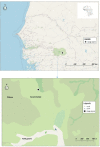Gastrointestinal parasites of baboons (Papio papio) in Niokolo-Koba National Park, Senegal
- PMID: 36118726
- PMCID: PMC9473380
- DOI: 10.5455/OVJ.2022.v12.i4.9
Gastrointestinal parasites of baboons (Papio papio) in Niokolo-Koba National Park, Senegal
Abstract
Background: Primates can harbor parasites that could be pathogenic or not for humans and primates themselves. It is necessary to know the parasitological situation of the primates that are under surveillance in the park.
Aim: To estimate the prevalence and diversity of gastrointestinal parasites, including zoonotic potential parasites, in baboons in the Niokolo-Koba National Park located in Senegal.
Method: Fecal samples (n = 50) from two groups of baboons (A and B) were collected in October 2019. The samples were processed using the flotation technique and the modified Ritchie method. Slides were examined microscopically and the parasite identification was based on morphology, color, and parasite content.
Results: A total of seven nematodes (Strongyloides sp., Trichirus sp., Ancylostoma sp., Mammo monogamus, Enterobius sp., Strongyloides stercoralis, Strongyle digestif), one cestode (Bertiella sp.), and one trematode (Fasciolopsis sp.) were identified. The overall prevalence was 78%, while the prevalence of poly-infected samples was 49%. The parasite with zoonotic potential, S. stercoralis, was identified in group B samples. Trichuris sp., which is common and pathogenic to humans and primates, was present with prevalence of 52% and of 32% in groups A and B, respectively.
Conclusion: These results suggest that baboons are infested with zoonotic parasites and this situation could expose people working in this park to infection. Contact between humans and these baboons or their feces could expose them to infection with zoonotic parasites.
Keywords: Baboons; Gastrointestinal parasites; Niokolo-Koba National Park; Zoonoses.
Conflict of interest statement
The authors declare that there is no conflict of interest.
Figures


References
-
- Adetunji V.E. Prevalence of gastro-intestinal parasites in primates and their keepers from two zoological gardens in Ibadan, Nigeria. Sokoto J. Vet. Sci. 2014;12(2):25–30.
-
- Allela N.L. Thèse: Méd. Vét. Toulouse, France: 2005. Contribution de l’étude de l’impact de la santé des primates en aires protégées sur celles des populations humaines: examens parasitologiques chez les travailleurs du WCS et chez les mandrills (Mandrillus sphinx) du parc national de la Lopé; p. 72.
-
- Anderson R.M, Gordon D.M. Processes influencing the distribution of parasite numbers within host populations with special emphasis on parasite-induced host mortalities. Parasitology. 1982;85(2):373–398. - PubMed
-
- Anderson R.M, May R.M. Oxford, UK: Oxford University Press; 1991. Infectious diseases of humans: dynamics and control; p. 746.
-
- Appleton C.C, Brain C. Gastro-intestinal parasites of Papio cynocephalusursinus living in the central Namib desert, Namibia. Afr. J. Ecol. 1995;33(3):257–265.
Publication types
MeSH terms
LinkOut - more resources
Full Text Sources
